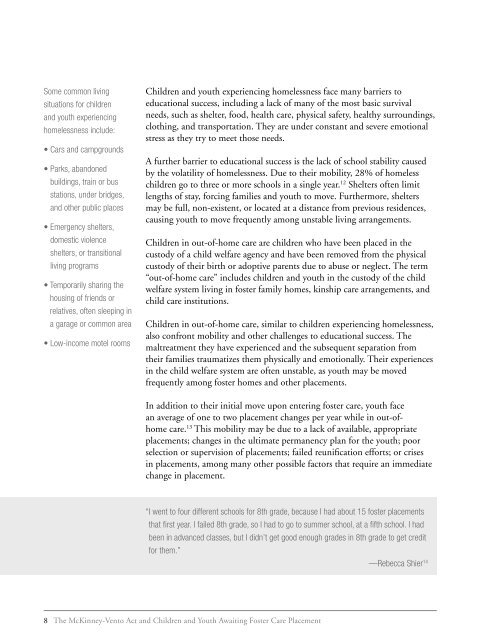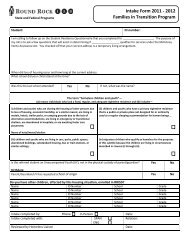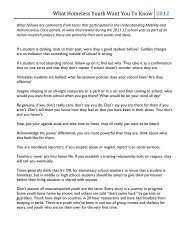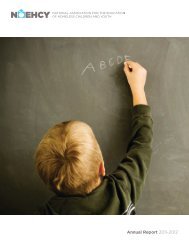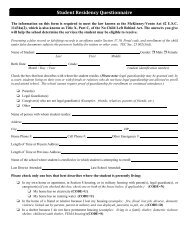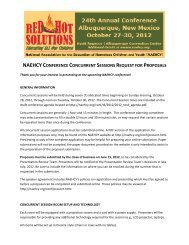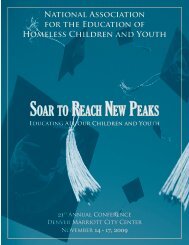The McKinney-Vento Act and Children and Youth ... - State of Michigan
The McKinney-Vento Act and Children and Youth ... - State of Michigan
The McKinney-Vento Act and Children and Youth ... - State of Michigan
You also want an ePaper? Increase the reach of your titles
YUMPU automatically turns print PDFs into web optimized ePapers that Google loves.
Some common living<br />
situations for children<br />
<strong>and</strong> youth experiencing<br />
homelessness include:<br />
• Cars <strong>and</strong> campgrounds<br />
• Parks, ab<strong>and</strong>oned<br />
buildings, train or bus<br />
stations, under bridges,<br />
<strong>and</strong> other public places<br />
• Emergency shelters,<br />
domestic violence<br />
shelters, or transitional<br />
living programs<br />
• Temporarily sharing the<br />
housing <strong>of</strong> friends or<br />
relatives, <strong>of</strong>ten sleeping in<br />
a garage or common area<br />
• Low-income motel rooms<br />
<strong>Children</strong> <strong>and</strong> youth experiencing homelessness face many barriers to<br />
educational success, including a lack <strong>of</strong> many <strong>of</strong> the most basic survival<br />
needs, such as shelter, food, health care, physical safety, healthy surroundings,<br />
clothing, <strong>and</strong> transportation. <strong>The</strong>y are under constant <strong>and</strong> severe emotional<br />
stress as they try to meet those needs.<br />
A further barrier to educational success is the lack <strong>of</strong> school stability caused<br />
by the volatility <strong>of</strong> homelessness. Due to their mobility, 28% <strong>of</strong> homeless<br />
children go to three or more schools in a single year. 12 Shelters <strong>of</strong>ten limit<br />
lengths <strong>of</strong> stay, forcing families <strong>and</strong> youth to move. Furthermore, shelters<br />
may be full, non-existent, or located at a distance from previous residences,<br />
causing youth to move frequently among unstable living arrangements.<br />
<strong>Children</strong> in out-<strong>of</strong>-home care are children who have been placed in the<br />
custody <strong>of</strong> a child welfare agency <strong>and</strong> have been removed from the physical<br />
custody <strong>of</strong> their birth or adoptive parents due to abuse or neglect. <strong>The</strong> term<br />
“out-<strong>of</strong>-home care” includes children <strong>and</strong> youth in the custody <strong>of</strong> the child<br />
welfare system living in foster family homes, kinship care arrangements, <strong>and</strong><br />
child care institutions.<br />
<strong>Children</strong> in out-<strong>of</strong>-home care, similar to children experiencing homelessness,<br />
also confront mobility <strong>and</strong> other challenges to educational success. <strong>The</strong><br />
maltreatment they have experienced <strong>and</strong> the subsequent separation from<br />
their families traumatizes them physically <strong>and</strong> emotionally. <strong>The</strong>ir experiences<br />
in the child welfare system are <strong>of</strong>ten unstable, as youth may be moved<br />
frequently among foster homes <strong>and</strong> other placements.<br />
In addition to their initial move upon entering foster care, youth face<br />
an average <strong>of</strong> one to two placement changes per year while in out-<strong>of</strong>home<br />
care. 13 This mobility may be due to a lack <strong>of</strong> available, appropriate<br />
placements; changes in the ultimate permanency plan for the youth; poor<br />
selection or supervision <strong>of</strong> placements; failed reunification efforts; or crises<br />
in placements, among many other possible factors that require an immediate<br />
change in placement.<br />
“ I went to four different schools for 8th grade, because I had about 15 foster placements<br />
that first year. I failed 8th grade, so I had to go to summer school, at a fifth school. I had<br />
been in advanced classes, but I didn’t get good enough grades in 8th grade to get credit<br />
for them.”<br />
—Rebecca Shier 14<br />
8 <strong>The</strong> <strong>McKinney</strong>-<strong>Vento</strong> <strong>Act</strong> <strong>and</strong> <strong>Children</strong> <strong>and</strong> <strong>Youth</strong> Awaiting Foster Care Placement


